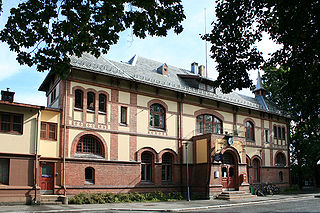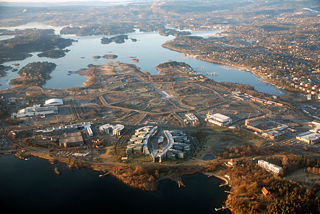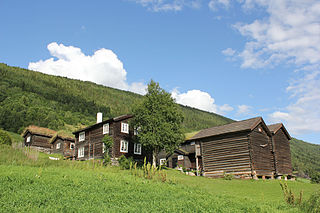Coordinates: 59°56′26.04″N10°46′30.66″E / 59.9405667°N 10.7751833°E

A geographic coordinate system is a coordinate system that enables every location on Earth to be specified by a set of numbers, letters or symbols. The coordinates are often chosen such that one of the numbers represents a vertical position and two or three of the numbers represent a horizontal position; alternatively, a geographic position may be expressed in a combined three-dimensional Cartesian vector. A common choice of coordinates is latitude, longitude and elevation. To specify a location on a plane requires a map projection.

Åsen is a neighborhood divided between the boroughs of Sagene and Nordre Aker in Oslo, Norway.

Sagene is a district of the city of Oslo, Norway. The area became part of the city of Oslo in 1859. The name Sagene itself is the plural of the Norwegian word for "saw", reflecting all the old industrial mechanical saws powered by the river Akerselva in this area in the 19th and early 20th centuries.

Nordre Aker is a district of the city of Oslo, Norway.

Oslo is the capital and most populous city of Norway. It constitutes both a county and a municipality. Founded in the year 1040 as Ánslo, and established as a kaupstad or trading place in 1048 by Harald Hardrada, the city was elevated to a bishopric in 1070 and a capital under Haakon V of Norway around 1300. Personal unions with Denmark from 1397 to 1523 and again from 1536 to 1814 reduced its influence, and with Sweden from 1814 to 1905 it functioned as a co-official capital. After being destroyed by a fire in 1624, during the reign of King Christian IV, a new city was built closer to Akershus Fortress and named Christiania in the king's honour. It was established as a municipality (formannskapsdistrikt) on 1 January 1838. The city's name was spelled Kristiania between 1877 and 1897 by state and municipal authorities. In 1925 the city was renamed Oslo.
The neighbourhood is named after the old farm Åsen [1] (Norse Ósin, from originally *Ásvin). The first element is áss m 'mountain ridge'[ dubious ] (here referring to Grefsenåsen), the last element is vin f 'meadow'.

Grefsenåsen is a hill in Lillomarka in Oslo, Norway. The height is 377 meter.

A meadow is a field habitat vegetated by grass and other non-woody plants (grassland).
The name is often misunderstood as åsen, the finite form of ås (the modern Norwegian form of áss), and is then wrongly pronounced with accent 1 - but the correct pronunciation is with accent 2.
Åsen farm was owned by the Catholic Church until the Reformation, when it came on private hands. It was split in three in 1810. When the Gjøvik Line was constructed to run through Åsen's farmlands, and it was parceled out to residencies. The municipality erected residential complexes there in the 1920s and 1930s, supplemented by blocks in the late 1940s. [1]

The Gjøvik Line is a Norwegian railway line between Oslo and Gjøvik. It was originally named the North Line (Nordbanen) and ran between Grefsen and Røykenvik. The line was completed to Gjøvik in 1902. The Gjøvik Line was one of the first lines of the Norwegian railway system which was to be contracted on public service obligation, but it was the state owned Norges Statsbaner which won it through its subsidiary NSB Anbud.
At Nordre Åsen there is a sports field, which is a home field of Skeid Fotball and Skeid Bandy.

Skeid Fotball is a Norwegian football club from Oslo that currently plays in 1. divisjon, the second tier of the Norwegian football league system. Its current home field is Nordre Åsen, after the club stopped playing at Bislett after the 2012 season. In past decades it has gained a reputation as a talent factory for the larger clubs in Norwegian football, and it has produced several players for the national team such as Daniel Braaten, Daniel Fredheim Holm, Omar Elabdellaoui and Mohammed Abdellaoue. Other notable players include Paul Miller. Skeid played in 1. divisjon in 2009 after a short stint in the 2. divisjon. They finished champions of the Second Group of 2. divisjon in 2008. However, Skeid relegated again to 2. divisjon at end of 2009 season in 16th and last position despite a good start. In 2018, Skeid won 2. divisjon group 1 and was promoted to the 1. divisjon.












